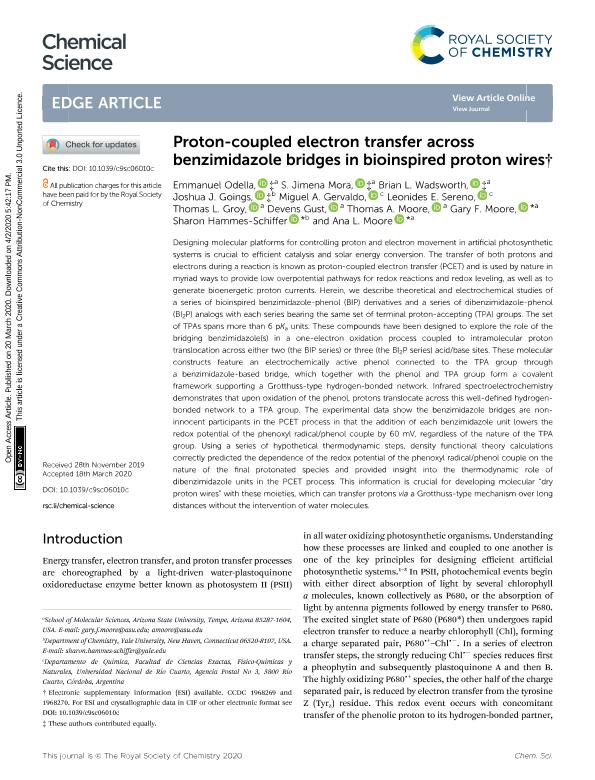Mostrar el registro sencillo del ítem
dc.contributor.author
Odella, Emmanuel

dc.contributor.author
Mora, S. Jimena
dc.contributor.author
Wadsworth, Brian L.
dc.contributor.author
Goings, Joshua J.
dc.contributor.author
Gervaldo, Miguel Andres

dc.contributor.author
Sereno, Leonides Edmundo

dc.contributor.author
Groy, Thomas L.
dc.contributor.author
Gust, Devens
dc.contributor.author
Moore, Thomas A.
dc.contributor.author
Moore, Gary F.
dc.contributor.author
Hammes Schiffer, Sharon
dc.contributor.author
Moore, Ana L.
dc.date.available
2020-12-02T17:46:06Z
dc.date.issued
2020-03
dc.identifier.citation
Odella, Emmanuel; Mora, S. Jimena; Wadsworth, Brian L.; Goings, Joshua J.; Gervaldo, Miguel Andres; et al.; Proton-coupled electron transfer across benzimidazole bridges in bioinspired proton wires; Royal Society of Chemistry; Chemical Science; 11; 15; 3-2020; 3820-3828
dc.identifier.issn
2041-6539
dc.identifier.uri
http://hdl.handle.net/11336/119647
dc.description.abstract
Designing molecular platforms for controlling proton and electron movement in artificial photosynthetic systems is crucial to efficient catalysis and solar energy conversion. The transfer of both protons and electrons during a reaction is known as proton-coupled electron transfer (PCET) and is used by nature in myriad ways to provide low overpotential pathways for redox reactions and redox leveling, as well as to generate bioenergetic proton currents. Herein, we describe theoretical and electrochemical studies of a series of bioinspired benzimidazole-phenol (BIP) derivatives and a series of dibenzimidazole-phenol (BI2P) analogs with each series bearing the same set of terminal proton-accepting (TPA) groups. The set of TPAs spans more than 6 pKa units. These compounds have been designed to explore the role of the bridging benzimidazole(s) in a one-electron oxidation process coupled to intramolecular proton translocation across either two (the BIP series) or three (the BI2P series) acid/base sites. These molecular constructs feature an electrochemically active phenol connected to the TPA group through a benzimidazole-based bridge, which together with the phenol and TPA group form a covalent framework supporting a Grotthuss-type hydrogen-bonded network. Infrared spectroelectrochemistry demonstrates that upon oxidation of the phenol, protons translocate across this well-defined hydrogen-bonded network to a TPA group. The experimental data show the benzimidazole bridges are non-innocent participants in the PCET process in that the addition of each benzimidazole unit lowers the redox potential of the phenoxyl radical/phenol couple by 60 mV, regardless of the nature of the TPA group. Using a series of hypothetical thermodynamic steps, density functional theory calculations correctly predicted the dependence of the redox potential of the phenoxyl radical/phenol couple on the nature of the final protonated species and provided insight into the thermodynamic role of dibenzimidazole units in the PCET process. This information is crucial for developing molecular "dry proton wires" with these moieties, which can transfer protons via a Grotthuss-type mechanism over long distances without the intervention of water molecules.
dc.format
application/pdf
dc.language.iso
eng
dc.publisher
Royal Society of Chemistry

dc.rights
info:eu-repo/semantics/openAccess
dc.rights.uri
https://creativecommons.org/licenses/by-nc/2.5/ar/
dc.subject
PROTON-COUPLED ELECTRON TRANSFER
dc.subject
BENZIMIDAZOLE-PHENOL
dc.subject.classification
Química Orgánica

dc.subject.classification
Ciencias Químicas

dc.subject.classification
CIENCIAS NATURALES Y EXACTAS

dc.title
Proton-coupled electron transfer across benzimidazole bridges in bioinspired proton wires
dc.type
info:eu-repo/semantics/article
dc.type
info:ar-repo/semantics/artículo
dc.type
info:eu-repo/semantics/publishedVersion
dc.date.updated
2020-08-04T15:09:18Z
dc.journal.volume
11
dc.journal.number
15
dc.journal.pagination
3820-3828
dc.journal.pais
Reino Unido

dc.journal.ciudad
Londres
dc.description.fil
Fil: Odella, Emmanuel. Arizona State University; Estados Unidos
dc.description.fil
Fil: Mora, S. Jimena. Arizona State University; Estados Unidos
dc.description.fil
Fil: Wadsworth, Brian L.. Arizona State University; Estados Unidos
dc.description.fil
Fil: Goings, Joshua J.. University of Yale. Yale School of Forestry & Environmental Studies; Estados Unidos
dc.description.fil
Fil: Gervaldo, Miguel Andres. Universidad Nacional de Río Cuarto. Facultad de Ciencias Exactas Fisicoquímicas y Naturales. Instituto de Investigaciones en Tecnologías Energéticas y Materiales Avanzados. - Consejo Nacional de Investigaciones Científicas y Técnicas. Centro Científico Tecnológico Conicet - Córdoba. Instituto de Investigaciones en Tecnologías Energéticas y Materiales Avanzados; Argentina
dc.description.fil
Fil: Sereno, Leonides Edmundo. Universidad Nacional de Río Cuarto. Facultad de Ciencias Exactas Fisicoquímicas y Naturales. Instituto de Investigaciones en Tecnologías Energéticas y Materiales Avanzados. - Consejo Nacional de Investigaciones Científicas y Técnicas. Centro Científico Tecnológico Conicet - Córdoba. Instituto de Investigaciones en Tecnologías Energéticas y Materiales Avanzados; Argentina
dc.description.fil
Fil: Groy, Thomas L.. Arizona State University; Estados Unidos
dc.description.fil
Fil: Gust, Devens. Arizona State University; Estados Unidos
dc.description.fil
Fil: Moore, Thomas A.. Arizona State University; Estados Unidos
dc.description.fil
Fil: Moore, Gary F.. Arizona State University; Estados Unidos
dc.description.fil
Fil: Hammes Schiffer, Sharon. University of Yale. Yale School of Forestry & Environmental Studies; Estados Unidos
dc.description.fil
Fil: Moore, Ana L.. Arizona State University; Estados Unidos
dc.journal.title
Chemical Science
dc.relation.alternativeid
info:eu-repo/semantics/altIdentifier/doi/http://dx.doi.org/10.1039/C9SC06010C
Archivos asociados
